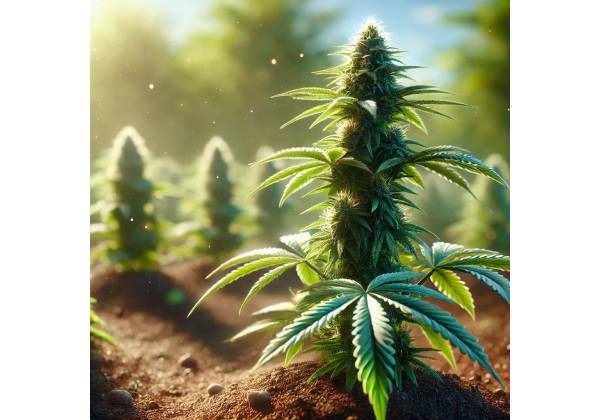
Cannabis (Cannabis sativa) is a plant that has captured global attention for millennia. Sometimes referred to by colloquial names like “marijuana” or “hemp” (depending on its use and THC content), cannabis stands at the intersection of cultural, medicinal, and industrial interest. Historically revered in ancient pharmacopeias, it later found itself subject to intense legal and social debates over psychoactivity, safety, and medical potential. Today, the conversation continues to evolve, with an expanding body of research examining cannabis for wellness, industrial hemp fiber, or even recreational contexts, where permitted by local laws.
This herb comprises numerous varieties and cultivars, each with different profiles of cannabinoids—unique compounds that interact with the human body in intricate ways. Some strains deliver high THC (the compound responsible for euphoria), while others focus on CBD (often linked with potential calming or anti-inflammatory properties). From a broader perspective, cannabis also boasts an array of terpenes contributing to its trademark aromas, plus a long history of industrial use in textiles, paper, and building materials.
In this comprehensive article, we’ll explore cannabis from multiple angles: how to identify its botanical traits, a look at its deep historical roots, the chemical composition underlying its effects, possible health benefits, and the ways it’s applied in modern contexts. We’ll also address the ongoing scientific research investigating cannabis and the safety considerations crucial for responsible use. Whether you’re new to this herb or familiar with its many facets, a balanced understanding of cannabis can help you navigate the complexities surrounding it.
- May offer potential supportive benefits for pain and inflammation
- Features a mix of cannabinoids like THC and CBD with unique physiological influences
- Includes aromatic terpenes that can modulate effects and flavor
- Historically used for fiber, paper, and seed-based nutrition
- Holds a complicated legal status, varying widely by country and region
Table of Contents
- Cannabis: Botanical Identifiers and Plant Overview
- Cannabis: Historical Context and Evolving Cultural Standing
- Cannabis: Principal Chemical Composition and Active Elements
- Cannabis: Potential Wellness Contributions and Observed Outcomes
- Cannabis: Defining Properties and Notable Attributes
- Cannabis: Applications, Precautions, and Responsible Use
- Cannabis: Highlighted Studies and Scholarly Investigations
- FAQ
Cannabis: Botanical Identifiers and Plant Overview
Species and Subtypes
Cannabis sativa is technically just one species name historically assigned to cannabis, but disputes over classification have led to references like Cannabis indica and Cannabis ruderalis as well. In practical terms, these subtypes differ in size, shape, leaf structure, and cannabinoid makeup:
- Sativa: Often tall, with narrow leaves, and known for potentially uplifting or energizing effects.
- Indica: Shorter, bushy growth, broader leaves, occasionally associated with relaxing or sedative influences.
- Ruderalis: Less common in commercial usage, known for its auto-flowering trait (blossoming based on age rather than light cycle).
Modern breeding has produced hybrids merging these traits for desired flavors, effects, or horticultural outcomes.
Physical Description
- Leaves: Distinctive serrated, palmate leaves with anywhere from 5 to 9 leaflets. The arrangement forms that iconic shape recognized worldwide. Color can range from lighter lime-green in some strains to darker forest-green in others.
- Height and Growth Pattern: Sativa-leaning plants can reach upwards of 10 to 15 feet in open soil, while indica-leaning types typically remain under 6 feet. Hydroponic or indoor grows vary widely.
- Flowers (Buds): Cannabis is dioecious, meaning male and female flowers can appear on separate plants. Cultivators often favor female plants for producing resinous buds rich in cannabinoids. The buds form dense clusters containing sticky trichomes.
- Aroma: Depending on terpenes, cannabis buds can evoke scents like pine, citrus, berry, or diesel. This diversity is a hallmark of specialized breeding lines.
Natural Habitat and Cultivation
Cannabis sativa originally thrived in Central Asia before human intervention spread it across the globe. Today, it’s cultivated in countless environments—indoors under controlled conditions or outdoors in fields or greenhouses. The plant typically prefers:
- Rich, Loamy Soil: Good drainage and balanced nutrients for robust growth.
- Adequate Sunlight: At least 5–6 hours of direct sun in outdoor settings, though many indoor setups use powerful artificial lighting.
- Moderate Climate: Temperature extremes can stress the plant, though some strains are bred for cooler or warmer conditions.
Lifecycle and Harvesting
Cannabis has an annual growth cycle:
- Germination: Seeds sprout within days when moisture and warmth align.
- Vegetative Stage: Leaves, stems, and overall height expand, guided by available light hours.
- Flowering Phase: As light durations shorten (outdoors in late summer or manipulated indoors), female plants produce buds.
- Harvest: Once trichomes shift to milky or amber (signaling peak resin production), cultivators cut and dry the plants or buds. This drying and curing process significantly impacts flavor and effects.
Hemp vs. Marijuana
Legally, “hemp” typically refers to cannabis varieties with negligible THC (often below 0.3%), grown for fiber, seeds, or CBD. “Marijuana” pertains to higher-THC cultivars, grown for psychoactive or medical use. Despite their differences in use and legal classification, they share the same overarching species background.
These botanical highlights set the stage for understanding cannabis’s myriad forms: from tall, fibrous hemp fields to compact, high-THC indoor strains carefully tailored for potency. All revolve around the same fundamental plant, shaped by environment, genetics, and centuries of human involvement.
Cannabis: Historical Context and Evolving Cultural Standing
Ancient Roots and Early Spread
Archaeological evidence suggests cannabis was cultivated thousands of years ago in regions such as present-day China and Central Asia:
- Fiber and Textile Use: Early societies recognized hemp’s tough fibers, using them for rope, cloth, and even early paper forms.
- Seeds as Food: The seeds often provided a source of protein and healthy fats.
- Ritual or Medicinal: Some cultures utilized the psychoactive varieties in rituals or folk treatments, referencing mild analgesic or anti-nausea properties.
Arrival in the Middle East and Africa
Through trade routes like the Silk Road, cannabis seeds and herbal knowledge migrated to the Middle East. There, it found acceptance in certain spiritual or everyday contexts (though direct consumption of cannabis, especially in psychoactive forms, garnered varied stances within religious frameworks). Over centuries, cannabis also spread to East Africa, recognized in local traditions for mild sedation or integrated into social contexts.
Western Recognition and Colonial Era
In Europe, hemp cultivation soared from the Middle Ages onward, fueled by demand for robust maritime ropes and sails. Over time:
- 18th–19th Centuries: Explorers and doctors brought back intriguing accounts of cannabis’s possible analgesic or sedative uses from Asia or North Africa. Writers like Charles Baudelaire in France penned about hashish clubs, stoking fascination with psychoactive experiences.
- Industrial Hemp: Scenes of hemp fields in countries like Russia or France became common, as hemp underpinned rope, paper, and textile industries.
Twentieth-Century Regulation
Though once embraced for multiple reasons, cannabis faced a wave of prohibition in various countries starting in the early 20th century:
- United States: The Marihuana Tax Act (1937) limited cannabis usage, culminating in a stricter classification in later decades under the Controlled Substances Act.
- Global Outlook: Many nations followed suit, citing psychoactive concerns and moral panic. The stigma overshadowed hemp’s industrial utility, restricting cultivation severely in most regions.
Contemporary Shifts
In recent decades, numerous jurisdictions have revisited cannabis laws, spurred by:
- Medical Marijuana: Empirical research suggests it may help with certain conditions like chronic pain, epilepsy, or chemotherapy-induced nausea. This led to medical cannabis legalization in many areas.
- CBD and Wellness: The non-psychoactive cannabinoid CBD gained massive popularity for alleged stress relief or anti-inflammatory potential, fueling hemp’s comeback in legal frameworks.
- Adult Recreational Use: Some regions fully legalized cannabis for adult consumption, leading to regulated markets for diverse products—flowers, edibles, concentrates, topicals, etc.
Cultural Renaissance
Public perception of cannabis has changed dramatically in some societies, shifting from taboo to (in certain places) a recognized option for relaxation or health management. Meanwhile, debates persist regarding legalization’s societal impacts, responsible usage, and the best ways to ensure safety.
Throughout these shifts, cannabis remains a symbol of both cultural identity and controversy—celebrated as a beneficial herb in certain contexts, yet facing ongoing legal complexities. With knowledge expanding and attitudes evolving, cannabis stands in a unique historical moment: bridging ancient tradition with cutting-edge research and policy reforms in a rapidly changing global landscape.
Cannabis: Principal Chemical Composition and Active Elements
Cannabis stands out among plants for its rich ensemble of cannabinoids, terpenes, and flavonoids—compounds that collectively shape the herb’s aroma, flavor, and physiological impacts. Understanding these chemicals is key to grasping why cannabis can influence mood, pain perception, appetite, and more.
Cannabinoids
Cannabinoids form the heart of cannabis’s chemical allure, with over 100 identified, though only a few are well-researched:
- Tetrahydrocannabinol (THC): The prime psychoactive constituent. THC binds to cannabinoid receptors (CB1, primarily in the brain) to produce euphoria or sedation, among other effects.
- Cannabidiol (CBD): Non-psychoactive, often praised for potential anti-inflammatory, anxiolytic, or seizure-reducing benefits. It primarily interacts with receptor systems indirectly, modulating the endocannabinoid system.
- Cannabinol (CBN): Forms as THC oxidizes; mild sedation is often attributed to CBN, though it’s less potent than THC.
- Cannabigerol (CBG): Referred to as a “parent cannabinoid,” as it’s a precursor to many other cannabinoids. Preliminary studies link it to possible neuroprotective or antibacterial properties.
- Cannabichromene (CBC): Another lesser-known compound that may exhibit synergy with THC and CBD in the so-called “entourage effect.”
Terpenes
Terpenes are fragrant oils that impart cannabis strains with diverse scents like lemon, pine, berry, or diesel. They also can shape or modify a strain’s perceived effects:
- Limonene: A citrusy scent, sometimes associated with elevated mood or stress relief.
- Pinene: Pine-like aroma, possibly supportive for focus or memory.
- Myrcene: Earthy, musky smell, often linked to sedation or relaxing influence.
- Linalool: Floral, reminiscent of lavender, correlated with calm or tranquil feelings.
- Caryophyllene: Peppery undertones, intriguing for its ability to interact with CB2 receptors in the immune system.
Flavonoids and Other Polyphenols
Beyond cannabinoids and terpenes, cannabis also contains flavonoids that can:
- Contribute to Color: Strains with purple hues, for instance, may hold anthocyanins or other pigmented compounds.
- Offer Antioxidant Potential: Many flavonoids have recognized antioxidant or anti-inflammatory capacity in lab contexts.
Entourage Effect
A widely discussed concept is the “entourage effect,” the idea that cannabinoids, terpenes, and other compounds together produce synergy greater than any isolated compound alone. For instance, CBD can moderate THC’s psychoactive intensity, while terpenes might tweak the onset or nature of the high. This interplay underscores why full-spectrum or broad-spectrum cannabis extracts can differ significantly from purified THC or CBD alone.
Factors Influencing Chemical Profiles
Cannabis’s chemical makeup changes based on genotype (strain genetics), growth conditions (light, temperature, soil nutrients), harvest timing, and curing processes. Even the method of consumption (smoking, vaporizing, ingestion) influences how compounds transform—for example, THCA becomes THC upon heat activation (decarboxylation).
Testing and Labeling
In many legal markets, cannabis flower or products come with lab test results specifying THC and CBD percentages, plus minor cannabinoids or terpenes. This data helps consumers choose items aligned with their preferences—be it a high-THC strain for potent psychoactive effects, or a CBD-dominant extract for subtle, non-intoxicating support.
Altogether, cannabis’s multifaceted chemistry gives it a wide range of potential uses. The interplay of cannabinoids, terpenes, and other constituents forms a complex tapestry that can produce varied experiences, from sedation and relaxation to creative euphoria or subtle calm. Recognizing these chemical nuances helps users tailor their approach—whether for recreation, therapeutic hopes, or industrial hemp applications.
Cannabis: Potential Wellness Contributions and Observed Outcomes
Cannabis’s effects on well-being are multifaceted, spanning everything from analgesia and mood shifts to improved appetite or stress relief. Current discussions revolve around how the plant’s synergy of cannabinoids and terpenes might produce helpful or adverse results, depending on dosage, individual physiology, and the balance of compounds present.
Pain Relief and Anti-Inflammatory Possibilities
Many people turn to cannabis for mild to moderate pain:
- Neuropathic Pain: Some evidence suggests that THC and CBD can help reduce nerve pain, including discomfort linked to multiple sclerosis or diabetic neuropathy.
- Arthritis or Joint Pain: The anti-inflammatory characteristics observed in certain cannabinoids or terpenes might alleviate symptoms. In practice, responses vary widely across individuals.
Stress, Anxiety, and Mental Health
While cannabis might help individuals unwind, the picture is complex:
- Anxiolytic Potential: CBD in particular has shown promise for reducing certain anxiety markers. Meanwhile, strains high in THC could either calm or exacerbate anxiety, depending on dosage and personal sensitivity.
- Mood Lifting: Some users report improved mood or creativity. However, high THC doses can contribute to paranoia or anxious feelings, reinforcing the importance of mindful consumption.
Sleep and Relaxation
Numerous anecdotal accounts advocate cannabis for enhanced sleep quality:
- Falling Asleep Faster: Indica-leaning strains or those with certain terpenes (like myrcene or linalool) often encourage sedation, allowing easier transition to slumber.
- Less REM Sleep: There’s data indicating cannabis might reduce REM sleep, potentially affecting dream recall or other sleep architecture aspects.
Appetite Stimulation and Gastrointestinal Support
One of cannabis’s well-known features is “the munchies,” or increased appetite. Medicinally, this can be beneficial for:
- Chemotherapy Patients: Managing nausea, boosting food intake during anti-cancer treatments.
- Wasting Disorders: Conditions like HIV/AIDS or severe anorexia might see improved nutritional intake with cannabis use.
- Digestive Discomfort: Beyond appetite, some find relief from GI spasms or inflammatory bowel issues, though research remains preliminary.
Neurological and Epileptic Considerations
CBD-based treatments for certain rare epilepsy forms, such as Dravet syndrome or Lennox-Gastaut syndrome, are among the most scientifically validated uses of cannabis derivatives:
- FDA-Approved Medications: Some countries have authorized specific CBD-focused drugs for managing severe pediatric seizures.
- Emerging Avenues: Ongoing studies continue exploring the potential for broader neurological conditions, though results remain mixed or incomplete.
Metabolic and Cardiovascular Aspects
Limited studies explore cannabis’s influence on insulin sensitivity, weight management, or cardiovascular health:
- Weight Modulation: Contrarily to the notion of increased appetite, some data suggest cannabis might correlate with a lower body mass index in certain populations. Causation is not definitively established, so more research is necessary.
- Blood Pressure: THC can cause short-term changes in heart rate or blood pressure, typically requiring caution among individuals with known cardiac issues.
Balanced Perspective
While these potential benefits captivate interest, cannabis is no cure-all:
- Variable Responses: Genetic differences, prior health conditions, and personal tolerance shape how beneficial or detrimental cannabis use might be.
- Dosage and Delivery Method: Smoking, vaping, edibles, sublingual tinctures, or topical products deliver distinct onsets and durations. Finding an optimal approach is often a trial-and-error process.
- Regulatory Environment: Differing legal statuses worldwide mean that best practices for product testing, purity, and labeling also vary. Reliability of any claimed effect can hinge on product quality.
In short, cannabis can provide supportive benefits in targeted ways, especially under professional guidance or within structured medical frameworks. For those seeking general relaxation or mild symptomatic relief, moderate and informed usage can help achieve positive experiences. However, caution is indispensable to avert potential pitfalls associated with overuse or unsupervised consumption, especially for novices or individuals with specific health vulnerabilities.
Cannabis: Defining Properties and Notable Attributes
Cannabis’s properties weave together physiological, practical, and cultural elements, reflecting its broad usage across different societies. Whether you’re viewing it through the lens of pharmacology, industry, or personal wellness, key attributes shape how we approach this plant.
Psychoactive Potential
- THC-Induced Euphoria: The most iconic feature remains tetrahydrocannabinol’s capacity to produce altered mental states. At moderate or high doses, THC can yield relaxation, enhanced perception, or heightened creativity for some users, while others experience anxiety or paranoia if they exceed comfortable limits.
- Variable Potency: Modern cultivars can have THC levels ranging from under 1% to well above 20%. This demands caution, especially for new consumers trying high-THC products.
Cannabinoid Diversity
- CBD’s Non-Intoxicating Influence: Cannabidiol fosters interest in gentle wellness, as it typically won’t cause euphoria but might help offset THC’s intensity or deliver unique calming or anti-inflammatory edges.
- Other Minor Cannabinoids: With over 100 cannabinoids possible, each might play small but meaningful roles in modulating the plant’s total effect.
Terpene-Driven Aromas
The synergy of aromatic terpenes with cannabinoids influences:
- Flavor Profiles: Ranging from sweet citrus or earthy pine to spicy or diesel-like undertones, making each strain distinct.
- Physiological Nuances: Some believe certain terpenes guide sedation or energy, though formal proof is evolving.
Industrial and Environmental Utility
- Hemp Fiber: Low-THC cannabis offers robust fibers for textiles, rope, and biodegradable plastics.
- Hemp Seeds: Nutrient-dense seeds yield oil and protein-rich meal, recognized for healthy fatty acid profiles.
- Soil and Ecological Impact: Hemp cultivation can break up soil compaction or help remediate certain pollutants, though large-scale claims require verification.
Sociocultural Complexity
Cannabis’s intangible properties also matter:
- Religious or Spiritual: In certain traditions, it’s revered or used ceremonially, signifying connection or introspection.
- Lifestyle: For some, cannabis is embedded in a subculture or personal identity. For others, it remains a strictly medicinal or forbidden substance, reflecting local laws and personal ethics.
Safety and Tolerance
- High Tolerance Potential: Regular heavy users may require increasing amounts to achieve the same effects, risking overconsumption.
- Side Effects: Dry mouth, impaired coordination, short-term memory deficits, or anxiety can accompany usage. Certain individuals might be more prone to psychotic episodes or dependency if predisposed.
Intersection with Modern Tech
- Advanced Extraction: From rosin pressing to CO2 extraction, new methods refine how we harness cannabinoids for oils, tinctures, or vape cartridges.
- Genetic Selection: Breeders develop strains for medical or recreational ends, focusing on specific cannabinoids or terpene blends.
These properties form a tapestry illustrating cannabis’s distinct place in global societies. It’s not just about the psychoactive “high” or the hemp fiber in your eco-friendly tote bag. Instead, the plant’s mosaic of chemical, environmental, and cultural threads weaves into a singular herb with a complexity rarely matched elsewhere in the botanical realm.
Cannabis: Applications, Precautions, and Responsible Use
Cannabis can fill a variety of roles—ranging from personal relaxation aid to industrial hemp fiber. Yet it’s critical to respect potential side effects, intoxication risks, and legal frameworks. Below are some primary uses and key safety considerations to keep in mind.
Medicinal and Therapeutic Applications
- Chronic Pain Management: Some individuals find relief from persistent aches or nerve-related conditions, though results vary significantly.
- Anxiety and Sleep: Low doses of balanced THC:CBD strains might assist with mild stress or insomnia, while excessive THC can intensify anxiety in certain users.
- Epilepsy and Neurological Disorders: Prescription CBD-based medications have shown success in severe epilepsy forms.
- Palliative Care: End-of-life or cancer patients may experience appetite stimulation, mood lift, or reduced nausea from cannabis use.
Recreational Context
In regions where recreational cannabis is legal, people may consume it for enjoyment, socializing, or creative inspiration. Common methods:
- Smoking: Traditional joints or pipes remain popular. However, inhaling combusted plant matter can irritate the lungs.
- Vaporizing: A potentially less harsh alternative that heats the material to release active compounds without full combustion.
- Edibles: Infused foods or beverages provide a discreet and smoke-free route, though they carry delayed onset and longer-lasting effects.
- Topicals: Creams or lotions that might address localized discomfort but avoid systemic intoxication.
Industrial Hemp Products
- Textiles and Cloth: Hemp fiber yields durable, breathable fabrics that are often more eco-friendly than conventional cotton.
- Paper: The short growth cycle and robust fiber output can reduce deforestation pressures on wood-based paper sources.
- Bioplastics: Some manufacturers incorporate hemp cellulose into biodegradable plastic alternatives.
Safety and Legal Considerations
- Legal Status: Laws vary drastically—some countries or states fully permit recreational use, others only medical, and many still ban cannabis in most forms. Always check local regulations before buying or consuming.
- Dosage Control: Overconsumption, particularly with edibles or potent strains, can lead to acute anxiety, panic, or psychomotor impairment. Start “low and slow,” especially if you’re new or returning to cannabis after a break.
- Possible Dependency: Long-term heavy use can foster psychological dependence, with withdrawal symptoms like irritability, insomnia, or appetite changes upon cessation.
- Coordination and Reaction: Operating machinery, driving, or similar tasks should be avoided if under the influence. Cannabis significantly impairs reaction time and judgment.
- Mental Health: While some find cannabis beneficial for stress or depression, it may trigger paranoia or exacerbate underlying psychotic tendencies in predisposed individuals. Professional advice is recommended if you have a history of mental health concerns.
- Adulterants and Quality: Unregulated markets can see unsafe additives, mold, or residual pesticides in cannabis products. Third-party lab testing or reliable sources reduce such risks.
Guidelines for Responsible Use
- Know the Strain and Potency: Choose a balanced THC:CBD ratio if you’re seeking gentler effects.
- Mindful Setting: Use in a comfortable, familiar environment, especially if you’re new to psychoactive cannabis.
- Hydration and Snacks: Dry mouth or munchies are common side effects. Water and healthy snacks can maintain comfort.
- Medical Advice: If cannabis is used for a specific health issue, do so under the guidance of a medical professional, especially regarding drug interactions or pre-existing conditions.
By integrating caution and informed decision-making, individuals can better enjoy cannabis or harness its applications responsibly. This approach acknowledges the plant’s multifaceted nature—capable of offering both supportive benefits and potential pitfalls, dependent on the context and manner of use.
Cannabis: Notable Studies and Scholarly Investigations
The research landscape for cannabis has exploded over the past few decades, spurred by loosening legal restrictions in certain regions and rising public interest. While thousands of studies exist, we’ll spotlight a few that capture the plant’s diverse roles in medicine, mental health, and industrial usage.
Chronic Pain and Inflammation
- “Cannabinoids in the Management of Chronic Pain” (2017, Pain Journal): A systematic review analyzed over 25 randomized controlled trials. It suggested moderate evidence that THC/CBD combinations can help some individuals with neuropathic pain, though side effects like dizziness and sedation were relatively common.
- Arthritis Focus (2019, Journal of Rheumatology): Preliminary data on topical or inhaled cannabis for arthritis found short-term improvements in reported pain and stiffness, but the small sample size limited definitive conclusions.
Epilepsy and Neurological Disorders
- “Cannabidiol for Treatment-Resistant Seizures” (2018, New England Journal of Medicine): A landmark trial showed significant seizure reduction in children with Dravet syndrome using a purified CBD medication. This paved the way for subsequent approvals of CBD-based drugs in multiple countries.
Mental Health Applications
- “Cannabis and PTSD: Clinical Observations” (2020, Frontiers in Psychiatry): This observational study noted some PTSD patients reported fewer nightmares and improved sleep with cannabis use. However, it emphasized the need for controlled, large-scale trials to clarify safety and efficacy.
- Anxiety and Mood (2021, Journal of Affective Disorders): An analysis suggested that while low to moderate THC or balanced THC:CBD strains might reduce acute anxiety, heavy or frequent use correlated with worsened anxiety in some participants over time.
Potential for Opioid Reduction
- “Medical Cannabis and Opioid Overdose Mortality” (2014, JAMA Internal Medicine): Observational data from certain US states indicated that medical cannabis availability was associated with decreased opioid overdose rates. Confounding factors remain a challenge, but it sparked further research into cannabis as an adjunct or alternative to opioid painkillers.
Industrial Hemp Innovations
- “Hemp Fiber Composites: A Sustainable Future” (2020, Materials Engineering Review): This paper explored hemp-based composites’ mechanical strengths, concluding they could replace or significantly reduce synthetic plastics in certain automotive or construction applications while lowering environmental footprints.
FAQ
Is there a difference between hemp and marijuana?
Hemp and marijuana both come from Cannabis sativa but differ in THC content. Hemp typically contains minimal THC (commonly under 0.3%), used for fiber, seeds, or CBD extracts. Marijuana strains generally have higher THC levels, making them suitable for psychoactive or medical cannabis products.
Can cannabis help with anxiety?
Low or moderate doses of certain THC/CBD ratios may reduce anxiety for some people. However, high-THC strains can cause or heighten anxiety in others. CBD alone might offer anxiolytic benefits without the psychoactive effects. Always start with low doses and consult medical professionals if you have significant anxiety issues.
Is smoking the only way to use cannabis?
Not at all. Options include vaping, edibles, tinctures, topical creams, capsules, and even suppositories. Each method has distinct onset times and durations. Edibles, for example, have a slower onset but longer effects compared to inhalation routes like smoking or vaping.
What about side effects like paranoia or memory problems?
High THC doses or sensitivity can trigger paranoia or short-term memory impairment. These effects typically dissipate as the cannabis wears off, but frequent heavy use might lead to persistent cognitive challenges. Staying aware of dosage and strain potency can help manage or avoid such side effects.
Is cannabis legal where I live?
Cannabis laws vary worldwide—from complete prohibition to full legalization. Some places allow only medical cannabis, while others permit recreational use with restrictions. Check local regulations before buying, using, or traveling with cannabis, as penalties can be severe in certain jurisdictions.
Disclaimer
This information is for educational purposes only and does not serve as a substitute for professional medical advice. If you have specific health concerns or questions about cannabis use—especially in relation to medications or legal guidelines—please consult a qualified healthcare provider.
Feel free to share this article on Facebook, X (formerly Twitter), or any other platform you enjoy. Spreading accurate knowledge about cannabis helps others make informed decisions.










